
...islands
in the sky
There’s
one last
important consideration when looking at
the impact of planetary order in a chart, and that’s the
shape of
the chart
itself. The overall
pattern of the
chart – often
referred to as “Jones
patterns,” after astrologer Marc Edmund Jones who first named
a
variety of them
– will add emphasis to certain planets because of their
unique
positions in the
overall marching order of the chart.
Chart
patterns are in part significant because of the way planetary order highlights
or isolates certain planets
and their impact, giving
some more power than others around them. By definition, chart patterns
become
patterns (as opposed to random distribution) because they feature one
or more
distinct clusterings of planets. That means that when it comes to
progressions
and transits, those clusters get hit like they are islands in the
sky. Like
islands in
the sea, each sky-island has a prevailing, windward side
and a leeward
side –
the windward side is the edge earliest in the Zodiac (which takes
aspects
first) and the leeward is the is the last one to be hit, the latest in
the
Zodiac.
When
planetary weather crosses these islands and activates the planets
inside them, the windward planet
(or leading planet, or cutting planet, depending
on whose terminology you use) defines the nature of the whole
experience, as it
is the first, the opener, the one that gets earliest attention. The leeward
planet (or trailing planet)
is the closer and as such defines
how the
experience is finished up, its ends tied up, its conclusions and
harvests
defined and utilized. Also of significance is what signs and houses they
inhabit,
and also what aspect, if any, they hold between
them. And, altogether, the nature of each island is described by the
planets
that live there and the order in which they introduce themselves.
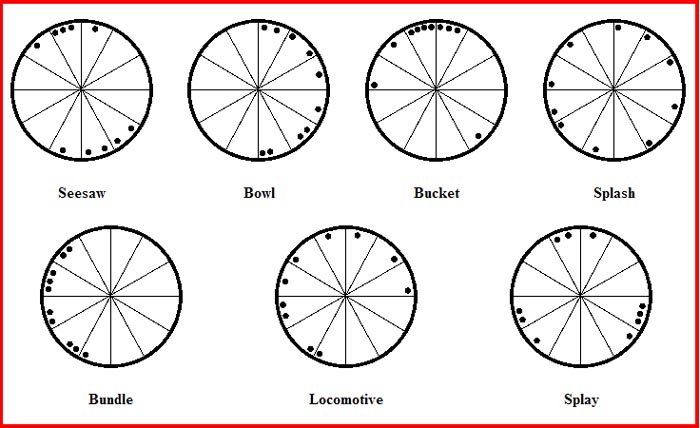
The
seven patterns
described by Marc
Edmund Jones are idealized,
don't quite match
every reality.
Here,
covering the standard Jones patterns plus some extras, are examples of
how and
why they manifest the way they do in personality, based on the
experiential development each pattern delivers:
The
Bowl
Pattern
–
All 10 planets lie to one side and occupy
only half the chart. It is associated with an extreme degree of
self-containment. When these are also entirely contained between the
lunar nodes (in
Vedic astrology called Kala
Sarpa yoga,
“the black serpent of time”), it has an even
greater
separating, containing
quality. Why so contained and separative? Simply because half the life
is spent
without aspecting conjunctions, creating a bit of an experiential
standoff with
the world. You get a whole spate of lunar transits for two weeks, then
nothing
for another two. When the transiting Moon is inside the bowl, you get a
preponderance of supportive aspects, when it’s not you get a
preponderance of dissonant ones. The result is you develop a feast-or-famine
sensibility, where
half of life is making hay while the Sun shines and storing up enough
to
survive alone without as much attention during the other half.
The
Bundle
Pattern
–
All 10 planets are bundled in 1/3 of the
chart, leaving 2/3 open. A highly-focused, unifaceted individual,
capable of
great intensity and depth in one given area, often to the exclusion of
all else
is the norm. It has all the alienation of the bowl and even more, as it
sees
less time of strongly engaging transits and must make it all happen in
a very brief,
intense experience, like living in
the high arctic with a very short growing
season. These are relatively
rare, and often reflect periods of
civil
desperation or isolation in general, a notable example being the middle
years of WWII.
The
See-Saw Pattern
- Two
groups of planets oppose each other, leaving two vacant arcs of
from 60° to 90° at opposite sides of the circle. A
consciousness of opposing
views in a world of conflict, with success dependent on correct
alignment is
the general prognosis here. Experientially, it’s about living
in
two different
worlds that manifest at opposite sides of every cycle. When one part
runs dry,
you draw on the other, like a
migratory animal that
alternates between two
favorable, but seasonal environments. People like this often actually
have two residences,
dual passports, and the like, indicatory of alternate
worlds both inside and out. Sometimes a little schizy, definitely with
Jekyll
and Hyde possibilities, often a work-home personality dichotomy.
 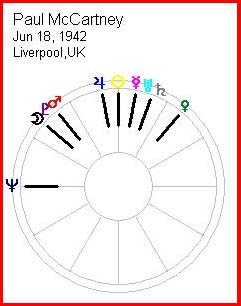 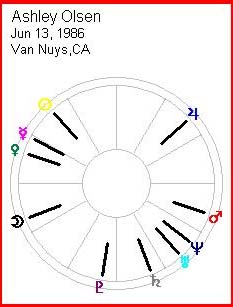
Bundle,
bowl, and
see-saw -- few actual charts are quite as true to the model as might
be, but are still effective.
The
Locomotive
Pattern
–
All 10 planets
occupy between ½ and 2/3 of the chart, leaving 1/3 or more
empty. This shows a
dynamic and practical capacity, especially characterized by the
qualities of
the leading planet. Motivated, sometimes to the point of being
overbearing,
this personality is particularly characterized by the leading planet.
Experientially, this is a bowl type with a single toehold in the
otherwise
opposing vacuum, and that tie to the rest of the world pulls the rest of the
personality along after this
one hope of avoiding separation. A
little like the
greyhound chasing the rabbit.
The
Bucket
Pattern
– 9
planets form a bowl while the 10th,
a singleton, looks like a handle. An inclination to make life swing
around some
special activity, which is characterized and controlled by the planet
comprising the handle, is indicated. This can also include a double
handle,
with
two planets less than a sign apart serving as alternate swing points,
like a
more focused see-saw, or perhaps the twin cords of a classical sling.
A single bucket where the handle
is near opposition to the leading edge of the bucket is also called a "scythe"
and has particular
locomotive intensity. Yet another version can be found where the nodes
are the
only handle for a bowl or bundle chart, signifying an abandonment to
fate, a
"cauldron of
destiny." In
a way, this is the extreme of the see-saw, where a single planet is set
apart
as the only alternate reality, against the preponderance of personal
experience. And, like the leading edge of the locomotive, the handle
planet is
the only “handle” on the rest of the world and
therefore
the focus of how/where
one takes advantage of it. A very tight version of the bucket is called
a
fan pattern,
in which 9
planets are concentrated into 1/3 of the chart, the 10th stands by
itself, emphasizing the opposition. It’s most common during
those
rare bundle
periods when the Moon spins out to become the handle.
  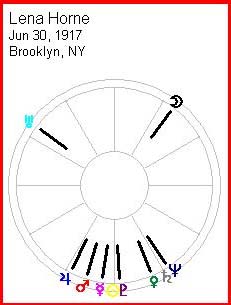
Locomotive,
bucket, and splay -- each takes transits and progressions with an
entirely different effect.
The
Splay Pattern – Three
or more
distinct points of
the chart are occupied, with strong and sharp aggregations of planets
irregularly spaced, leaving the rest empty.. This indicates a
purposeful
individuality, which chooses its outlet of self-expression and refuses
to be
pigeon-holed. A life full of separated pockets of intensity and focus,
sometimes
seemingly unrelated. Experientially, it is the hunter-gatherer of the
lot,
where there are multiple productive feeding grounds, with travel
between them.
Many ports, many storms, it has a sometimes harsh quality about it.
The
Splash
Pattern
–
All 10 planets well divided around the
wheel, with no noticeable gaps in the daily rising sequence. This
describes a
well-balanced nature with a capacity for universal interest, marked by
versatility and the seeming ability to find order in apparent
confusion. It is
in a way not a pattern at all, but a uniform regularity where there is
always
something happening, always fruit to
be gathered from the trees,
regardless of
season. There are no leading or trailing planets, no transit
“seasons” and thus
the pattern tends to make the classical “man for all
seasons.”
 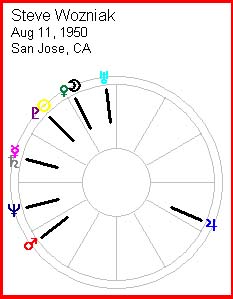 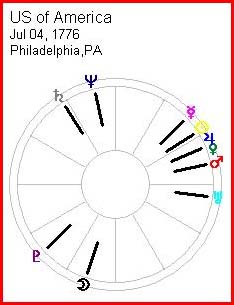
Splash has no leading
planet, Wozniak
has "fan" type bucket, USA has double bucket handle (or, might be a
splash or splay).
Windward
and Leeward.
The
leading edge of each of these islands in the sky is the first
to feel planetary weather in the form of transits and progressions and
this
planet lends its quality particularly to the whole island, as might be
expected. It’s the planet that holds that particular fort,
for
well or ill, the
first spotted by a lookout that names the rest. It’s the first foot ashore,
what you remember going in to the experience. The final planet in each
island
is the summation of the experience,
the last memory and farewell
(or good
riddance, as the case may be).
The
nature
of each is, of course,
affected by where they fall in the chart and their own support by or
afflictions from the rest of the chart or the planets within the
island. A
badly-afflicted leading planet invites in rolling disasters in the same
way a
damaged breakwater would. A firm, resilient, well-fortified one is
preferable.
A strongly-supported trailing planet means things turn out all right in
the
end, regardless, whereas an afflicted one can leave a bad taste in the
mouth
like a spoiled dessert at the end of a great dinner, or a wreck upon
leaving the
harbor.
Mixing
and Matching. Not all charts
fit easily into just one pattern.
The U.S. chart could be a double-handled bucket, a splash, or a splay,
depending on how you look at it. Some bowl charts have several clusters
arranged within their 180-degree spread so that they also act like a
splay within a bowl. And, many splash charts are not just evenly
distributed planets but multiple clusters that make them more like
overgrown splays. Add Chiron and the asteroids and you get even more
subtleties and combinations. The trick, in the end, is to look at it
from the order point of view -- who gets hit first by transits and how
long between hits, the experiential approach.
Aspect
Patterns.
Many
astrologers like to integrate the major aspect patterns (grand
trines, crosses, T-squares and the like) into the picture, and
it’s nice when
you can. A splay chart is often gathered around a grand trine, a bucket
around
a grand cross, and so on. But just as often they are not, so don’t link the
two
unnecessarily, unless they
are both there – they are two
separate (though
sometimes reinforcing) phenomena.
Note:
An analysis of each of the individual celebrity charts above may be
found at Matrix's Star Gazing
Archives...

Planetary Order I:
Rising Ahead of the Sun
Planetary Order II: Your
Ducks in a Row
And
every day, keep in touch with our
Astrology In The News section...take
a look!
--
Breaking news from
around the globe, plus articles, reviews -- it's all happening there,
changes daily...
|

